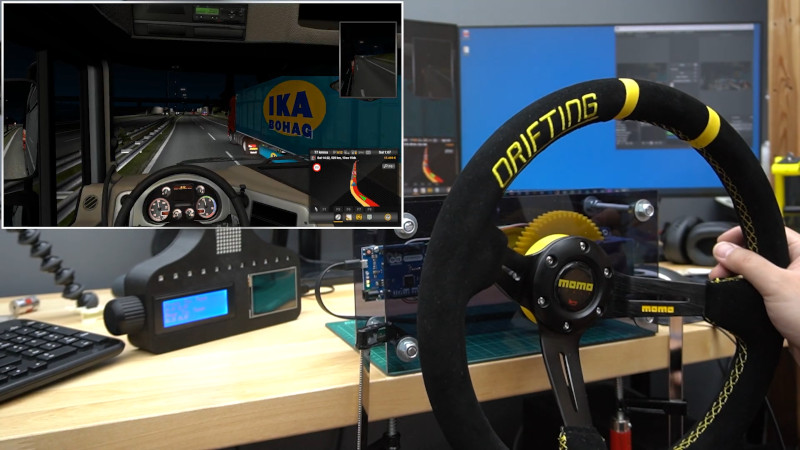There are many racing wheels on the market for the budding sim enthusiast. Unfortunately, lower end models tend to have a limited range of motion and ship with cheap plastic wheels that don’t feel good in the hand. As always, if what’s on the shelf doesn’t meet your needs, you can always build your own. [ilge]’s DIY racing wheel build is a great example of how to go about it.
It’s a no-frills build, with an Arduino Leonardo doing the USB Human Interface Device duties in this case. It reads a standard 10K potentiometer via an analog input to determine wheel position. To enable a realistic 900 degrees of motion, unlike the standard 270 degree rotation of the potentiometer, [ilge] uses 3D printed gears of 15 and 54 degrees respectively. This also has the benefit of allowing the wheel to be mounted to a stout bearing for smooth motion. The steering wheel itself is a high quality drift wheel from MOMO, and the benefit of building your own setup is that you can choose whatever wheel you like to taste.
It’s a simple build both mechanically and electronically speaking, but one that serves as a great entry into building a DIY sim for the beginner. We’d love to see further upgrades towards force feedback, or even shift paddles added on the back. Those looking to go all out can even consider building a motion platform. Video after the break.















” [ilge] uses 3D printed gears of 15 and 54 degrees respectively. ” .. Shouldn’t that be 54 teeth?
10 turn pots are in stock at Digikey starting at US$15 each. Just saying.
They likely also have high density quadrature encoders. Suddenly you’re no longer limited in rotation AND you don’t have to worry as much about electrical noise and bad contact.
High precision multiturn pots exist, but most commonly used for industrial and scientific instruments like power supplies and older oscilloscopes.
Buuut an absolute position (maybe combined with the more traditional “only measuring speed” optical or magnetic rotary encoder would definitely be better than a potentiometer.
Pretty sure a encoder is what they use in store sold versions.
You then need some kind of mechanical stop to prevent turning more than a steering wheel does. So you’ll still need the gears, I think.
Electromagnet and floating steel pin?
Toggle the magnet near the last rotation so the pin hits a fixed obstacle when the wheel is upside-down.
might as well go hunt for an old DC servo off an obsolete CNC machine…
Ok I’m lost\confused how can a vehicle have a steering wheel with “900 degrees of motion” or why you would want that. All replies considered, not all deemed to be of merit.
Because that is what cars have.
Only if you are talking standard street driven passenger cars. For some forms of racing, I have seen as little as 1/2 turn lock to lock steering boxes.
Simply means you can turn it a full turn and a half left or right (Similar to most cars). This means that for instance 20 degrees rotation equates to roughly 2 percent change in output. Cheap racing wheels often have less than 360 degrees rotation, so if you make that same 20 degree steering input it gives you 5,5% output change. Thus the larger degree of rotation gives you more precise steering. (Even better if you give it non linear response). A wheel with less rotation is easier to oversteer the car. (There’s diminishing returns because at some point rotating the wheel over large angles becomes too much work. 900 degrees seems to be the agreed on sweet spot.)
Street cars have that kind of motion, but not most racecars and is certainly not used when racing.
The hand over hand motion required to go more that 180 either way gets to be really cumbersome.
Even a lot of race cars have more than 360 degrees rotation to full lock in either direction. You rarely need that much input at speed, only in very tight corners. It’s all a trade-off.
“you can choose whatever wheel you like to taste”
I don’t know about you guys but I’m not prone to tasting my wheels.
You are missing out on so much goodness
Remembering some of the filthy cars I’ve seen, this might just put me off my breakfast. …Maybe.
Without force feedback it’s an exercise in futility mounted at an angle that will make your wrists hurt.
I was always under the impression that the low quality potentiometers (like the one in the post) wear out where the wiper touches the resistive element. Especially as the middle will be more used in this setting than the edges.
A multiturn pot (10 turns) is 15$ at respectable sites, and around 2-3$ on Aliexpress/Ebay. If 3600 degrees is too much, lower it with gearing.
And for the same price as a multiturn pot, an encoder module can be bought (eg. with TCUT1600X01), and there would be no worry about the wear&tear.
I imagine a cool solution with a high resolution rotary encoder and a stupidly strong motor for force feedback and limiting/setting the steering angle. In that way it could be adjusted for all kinds of vehicles – form a kart to a school bus.
There has been atleast one project here with a self done force feedback. Had a quite big motor in it too.
I have an old force feedback steering wheel, which i would like to upgrade to work in modern environments (it has USB 1.0, no driver since XP i think), but i haven’t got around to it, mostly because there hasn’t been many examples how to do that (software for the controller and a driver is needed) when i’ve been looking at it and because there hasn’t really been many driving games, that would interest me (I’76 forever!).
A direct drive Forcefeedback wheel is basically exactly what you are describing. (example: https://www.simracingbay.com/osw-assembled-direct-drive-kit-new/)